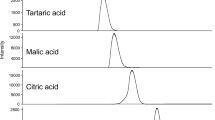Abstract
Relative quantities of d-amino acids, (%D) calculated from the sum of d- and l-amino acids were determined in bee honeys (n=6) by GC-SIM-MS. Amino acids were isolated by treatment with Dowex 50 W X8 cation exchanger and converted into N(O)-perfluoroacyl amino acid propyl esters. In all honeys d-Ala, ranging from 2.2–6.2% d-Ala, was detected. Other d-amino acids were also found, albeit not in all honeys and approached 5.9% d-Glx, 5.4% d-Lys, 3.0% d-Phe, 2.1% d-Orn, 1.7% d-Asx, 1.5% d-Ser, 0.1% d-Pro, and 0.4% d-Val in certain honeys. Quantities of d-amino acids increased very much on experimental heating of honeys in an oven and on a microwave treatment. Conventional heating of a forest honey (no. 1) at 65 °C for 450 h leads to an increase of d-Ala (2.2–12.5%), d-Pro (0.0–5.0%), d-Ser (1.5–9.1%), d-Asx (1.7–9.8%), d-Phe (0.4–5.0%) and d-Glx (1.5–5.8%); first numbers in parentheses refer to unheated honeys. Relative quantities of other d-amino acids also increased. Experimental heating of another forest honey (no. 2) in a microwave oven for 3 min at 180 W leads to an increase of d-Ala (3.7–11.0%), d-Glx (1.5–13.7%), d-Asx (0.7–10.2%), d-Phe (0.3–4.8%), d-Val (0–4.2%), and d-Pro (0.1–2.3%). Microwave treatment at 700 W for 1 min of a blossom honey (no. 3) leads to an increase of d-Ala (6.2–26.7%) and of d-Phe (3.0–10.9%). Microwave treatments were accompanied by intensive destruction of amino acids. Heating of a model mixture mimicking the major components of honey (d-glucose, d-fructose, and l-amino acids at 20% water content) at pH 2.6–9.0 and at 180 W for 1–3 min leads to the generation of d-amino acids and was also accompanied by intensive decay of amino acids. From the data it is concluded that d-amino acids are formed in honeys in the course of the Maillard reaction. A mechanism is presented based on amino acid racemization of reversibly formed Heyns and Amadori compounds (fructose-amino acids).




Similar content being viewed by others
References
Council Directive 2001/110/EC of 20 December 2001 relating to honey (L10/47 and Annex L10/50)
Anklam E (1998) Food Chemistry 63:549–562
White JW (1978) Adv Food Res 24:287–374
Davies AMC (1975) J Apicul Res 14:29–39
Gilbert J, Shepherd MJ, Wallwork MA, Harris RG (1981) J Apicul Res 20:125–135
Pirini A, Conte SL, Francioso O, Lercker G (1992) J High Res Chromatogr 15:165–170
Hausch M (1990) Dissertation, University of Hohenheim, Germany
Brückner H, Langer M, Lüpke M, Westhauser T, Godel H (1995) J Chromatogr A 697:229–245
Pawlowska M, Armstrong DW (1994) Chirality 6:270–276
Brückner H, Becker D, Lüpke M (1993) Chirality 5:385–392
Brückner H, Justus J, Kirschbaum J (2001) Amino Acids 21:429–433
Ledl F, Schleicher E (1990) Angew Chem Int Ed 29:565–594
Pätzold R, Brückner H (2005) In: Molnar-Perl I (ed) Quantitation of Amino Acids and Amines, Methods and Protocols. Journal of chromatography library, vol 70. Elsevier, Amsterdam, The Netherlands, pp 98–119
Winkler O (1955) Z Lebensm Unters Forsch 102:161–165
Brückner H, Pätzold R (2005) Amino Acids 29:61
Pätzold R, Brückner H (2005) In: Flegel M, Fridkin M, Gilon C, Slaninová J (eds) Proceedings of the 3rd international and 28th European peptide symposium, Kenes International, Geneva, Switzerland, pp 997–998
Bückner H, Kirschbaum J, Pätzold R (2002) In: Benedetti E, Pedone C (eds) Proceedings of the 27th European peptide symposium Edizioni Ziino, Napoli, Italy, pp 54–55
Ali H, Pätzold R, Brückner H (2005) Food Chem (in press), DOI 10.1016/j.foodchem.2005.08.056
Hofman T (1999) Eur Food Res Technol 209:113–121
van Boekel MAJS (2001) Nahrung/Food 65:150–159
Bell LN (1997) Food Chem 59:143–147
Hofman T, Heuberger S (1999) Z Lebensm Unters Forsch A 208:17–26
Heyns K, Paulsen H (1959) Liebigs Ann Chem 622:160–174
Anet EFLJ, Reynolds TM (1957) Aust J Chem 10:182–192
Noguchi M, Sato Y, Nishida K, Ando S, Tamaki E (1971) Agric Biol Chem 35:65–70.
Ciner-Doruk M, Eichner K (1979) Z Lebensm Unters Forsch A 168:9–20.
Cremer DR, Eichner K (2000) Eur Food Res Technol 211:247–251
Heinzler M, Eichner K (1991) Z Lebensm Unters Forsch 192:445–450
Pätzold R, Nieto-Rodgriguez A, Brückner H (2003) Chromatographia Suppl 57:S207–S211
Pätzold R, Brückner H (2005) J Agric Food Chem 53:9722–9729
Author information
Authors and Affiliations
Corresponding author
Additional information
Parts of the results have been presented at 9th International Congress on Amino Acids and Proteins, August 8–12, 2005, Vienna, Austria, and Euro Food Chem XIII, September 21–23, 2005, Hamburg, Germany.
Rights and permissions
About this article
Cite this article
Pätzold, R., Brückner, H. Gas chromatographic detection of d-amino acids in natural and thermally treated bee honeys and studies on the mechanism of their formation as result of the Maillard reaction. Eur Food Res Technol 223, 347–354 (2006). https://doi.org/10.1007/s00217-005-0211-y
Received:
Revised:
Accepted:
Published:
Issue Date:
DOI: https://doi.org/10.1007/s00217-005-0211-y




